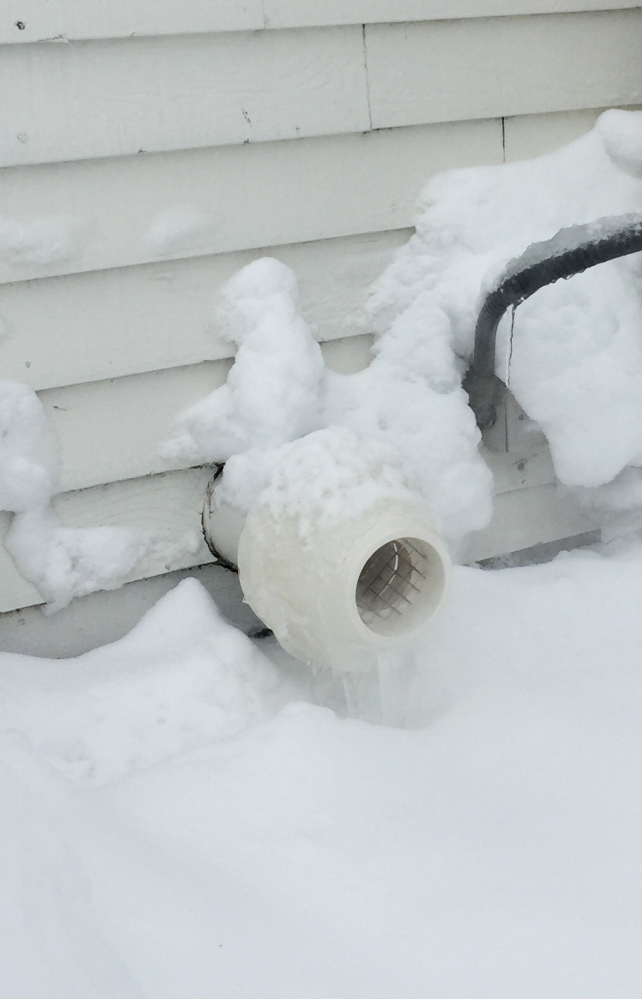YARMOUTH – Kent Ryden doesn’t know why he woke at 6:45 a.m. last Wednesday, but he’s lucky he did.
“I woke up, put my legs over the side of the bed and tried to stand up and realized I couldn’t,” he recalled Thursday. “I was very woozy and having trouble staying conscious.”
Ryden was able to call 911. Within minutes, he was in an ambulance receiving oxygen for carbon monoxide poisoning.
Firefighters discovered that the exhaust vent for the propane furnace at Ryden’s house on Hillside Street had been covered by snow drifts from the blizzard on Jan. 27. The level of carbon monoxide in his bedroom was 1,000 parts per million. Just 35 parts per million would activate a carbon monoxide alarm, but Ryden did not have one.
Ryden, 55, said he should have thought to clear the furnace vents but it didn’t even occur to him. He has lived in the house for the past five years and never had a similar problem. After his close call, he says he’ll make sure the vents are kept clear.
Ryden’s was one of many cases of suspected carbon monoxide poisoning in Maine over the past week or so. The surge followed several snowstorms, including the blizzard that dumped 2 feet of snow and more on much of the state.
The Northern New England Poison Control Center reported that in the week following the blizzard, it received 36 reports of confirmed or suspected carbon monoxide poisoning, 29 of them in Maine. The center might tally eight calls for carbon monoxide poisoning in a typical winter week, said Dr. Karen Simone, director of the poison control center, which covers New Hampshire, Vermont and Maine.
“A series of these cases involve people who were almost going to succumb but were able to get out on their own. They were sick or weak, physically unable to get out or can’t think well enough to get out,” she said.
Simone said the calls included everything from confirmed emergency room visits to carbon monoxide detectors being activated.
Carbon monoxide is an odorless, colorless gas found in combustion fumes, such as those made by cars and trucks, lanterns, stoves, gas ranges and heating systems. It can build up in unventilated areas.
It interferes with the body’s ability to get oxygen to the brain and the heart, which is why people are often disoriented or feel they are having a heart attack, Simone said.
Symptoms can include headache, dizziness, weakness, nausea, vomiting and confusion. Exposure can have lasting effects, such as memory loss and disorientation, and can be fatal.
“We have more snow coming, and of course, we’re worrying about people unable to deal with this or who don’t know how to,” she said.
Simone and area fire officials are urging residents to clear snow around furnace vents and car tailpipes, avoid running machinery or cars in confined spaces and make sure they have working carbon monoxide detectors. State law requires that detectors be installed in rental units, fire officials say.
Officials advise people who suspect carbon monoxide poisoning or whose carbon monoxide detector activates to go outdoors into fresh air and call 911.
Even hard-wired carbon monoxide detectors require fresh batteries every six months or they can signal a false alarm, said Yarmouth Fire Chief Mike Robitaille said.
Several types of household appliances, such as pellet furnaces, propane-powered clothes dryers or kerosene heaters have exhaust vents that should be kept clear of snow. Electric dryer vents should also be cleared to avoid condensation, which can lead to lint build-up, creating a fire hazard.
In Lewiston this week, about 100 workers and customers had to evacuate a building on Mollison Way that houses a bowling alley and two other businesses when carbon monoxide levels climbed above 2,000 parts per million and set off alarms. Snow had covered a rooftop heating unit, causing exhaust gases to get sucked back into the building, fire officials said.
Snow piling up on roofs can create other dangers.
Thursday morning, a rooftop heating unit at Marden’s Surplus & Salvage on Payne Road in Scarborough caught fire after snow blocked an intake vent, causing the heating unit to overheat, Deputy Fire Chief Glen Deering said. The fire was contained to the unit and the area immediately around it.
Send questions/comments to the editors.



Success. Please wait for the page to reload. If the page does not reload within 5 seconds, please refresh the page.
Enter your email and password to access comments.
Hi, to comment on stories you must . This profile is in addition to your subscription and website login.
Already have a commenting profile? .
Invalid username/password.
Please check your email to confirm and complete your registration.
Only subscribers are eligible to post comments. Please subscribe or login first for digital access. Here’s why.
Use the form below to reset your password. When you've submitted your account email, we will send an email with a reset code.